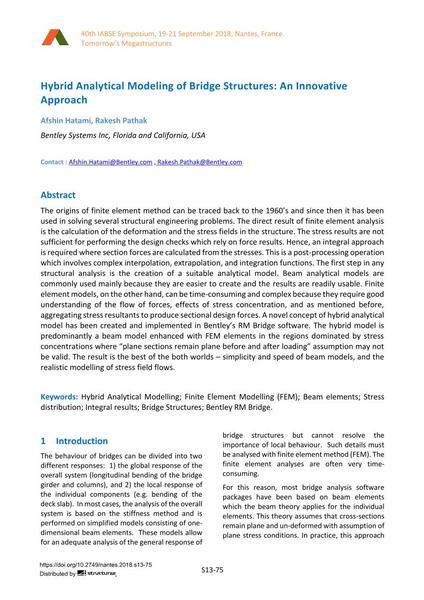Hybrid Analytical Modeling of Bridge Structures: An Innovative Approach

|
|
|||||||||||
Bibliographic Details
| Author(s): |
Afshin Hatami
(Bentley Systems Inc, Florida and California, USA)
Rakesh Pathak (Bentley Systems Inc, Florida and California, USA) |
||||
|---|---|---|---|---|---|
| Medium: | conference paper | ||||
| Language(s): | English | ||||
| Conference: | IABSE Symposium: Tomorrow’s Megastructures, Nantes, France, 19-21 September 2018 | ||||
| Published in: | IABSE Symposium Nantes 2018 | ||||
|
|||||
| Page(s): | S13-75 | ||||
| Total no. of pages: | 8 | ||||
| DOI: | 10.2749/nantes.2018.s13-75 | ||||
| Abstract: |
The origins of finite element method can be traced back to the 1960’s and since then it has been used in solving several structural engineering problems. The direct result of finite element analysis is the calculation of the deformation and the stress fields in the structure. The stress results are not sufficient for performing the design checks which rely on force results. Hence, an integral approach is required where section forces are calculated from the stresses. This is a post-processing operation which involves complex interpolation, extrapolation, and integration functions. The first step in any structural analysis is the creation of a suitable analytical model. Beam analytical models are commonly used mainly because they are easier to create and the results are readily usable. Finite element models, on the other hand, can be time-consuming and complex because they require good understanding of the flow of forces, effects of stress concentration, and as mentioned before, aggregating stress resultants to produce sectional design forces. A novel concept of hybrid analytical model has been created and implemented in Bentley’s RM Bridge software. The hybrid model is predominantly a beam model enhanced with FEM elements in the regions dominated by stress concentrations where “plane sections remain plane before and after loading” assumption may not be valid. The result is the best of the both worlds – simplicity and speed of beam models, and the realistic modelling of stress field flows. |
||||
| Keywords: |
finite element modeling (FEM) stress distribution Bridge structures hybrid analytical modelling Beam elements Integral results Bentley RM Bridge
|
||||
